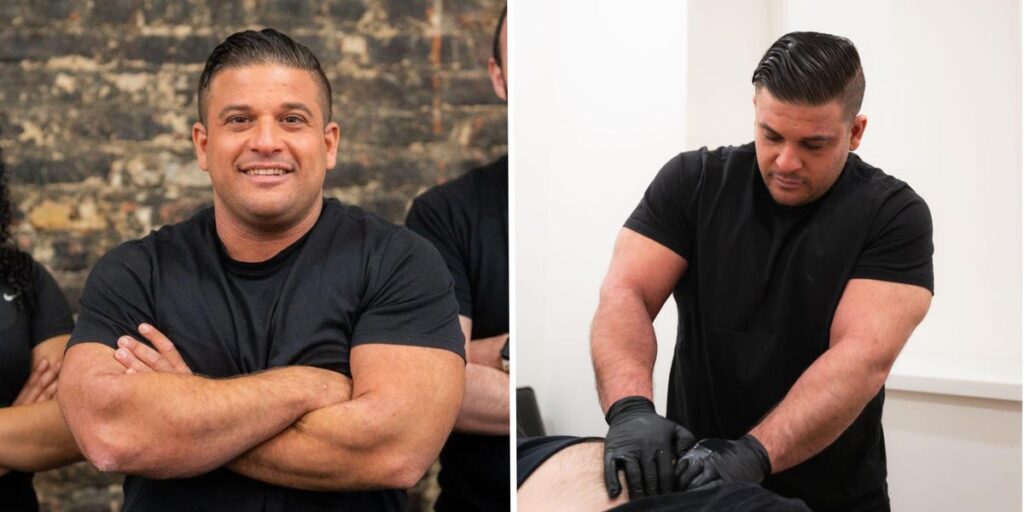Adam Gvili was 19 when he first started needing to pee 20 times a day.
It would take him six years of misdiagnoses, costly appointments, and ineffective treatments to learn that his pelvic floor — a body part typically associated with women — was the culprit.
Gvili, now 35 and a New York-based physical therapist specializing in male pelvic health, told Business Insider that needing to pee often was the most frustrating symptom and affected his quality of life.
“That sucked because I was constantly reorganizing my life based off that. I get in the car and I’m like ‘wait, maybe I shouldn’t have coffee now, that might affect me. It’s a diuretic. Okay, I’ll wait until I get to work.’
“Finally, I get to work. I was like, ‘okay, I’m going to a meeting now. This is not good. What if I have to pee? Maybe I should pee now.'”
Within six to eight months of treatment involving manual therapy and exercises, Gvili’s symptoms were gone.
“Part of the journey now is educating the masses on what pelvic floor is,” he said.
Gvili said that lots of men are unaware they even have a pelvic floor and feel shameful of intimate problems.
“As a man, so much is tied to this region,” he said. “I think it’s important that people feel supported and they know that this is temporary and once you find the right treatment, you’ll get better.”
Research suggests up to 16% of American men under 50 experience pelvic floor dysfunction, where the hammock of muscles that sit in the pelvis and help us pee, poop, and have sex aren’t working correctly. (For women, it’s around 40%).
Please help BI improve our Business, Tech, and Innovation coverage by sharing a bit about your role — it will help us tailor content that matters most to people like you.
What is your job title?
(1 of 2)
What products or services can you approve for purchase in your role?
(2 of 2)
this data to improve your site experience and for targeted advertising.
By continuing you agree that you accept the
Terms of Service
and
Privacy Policy
.
Thanks for sharing insights about your role.
While it’s more common for women to have loose pelvic floor muscles, causing symptoms like urinary or bowel incontinence, men tend to have an over-active, tight pelvic floor.
There are a number of causes of a tight pelvic floor, including stress (Bloomberg recently reported on the rise of tight pelvic floors on Wall Street), habitually holding in urine or poop, muscular damage from prolonged sitting, abnormal posture or gait, sexual trauma, or injury to the pelvic muscles during surgery or childbirth.
As well as needing to pee often, Gvili experienced constipation, occasional premature ejaculation, and soreness in the penile and rectal area after going to the bathroom. Some men also feel pain in their penis, rectum, groin, or testicles, and erectile dysfunction.
Gvili was prescribed antibiotics and antidepressants, which didn’t help
Gvili knew his frequent peeing, which was “driving him nuts,” wasn’t normal. He consulted his primary care physician, who referred him to a urologist. There, he “went through the gamut of testing” (physical exams, blood tests, and urine and sperm cultures) to check for inflammation or infection. Everything came back clear, so doctors would chalk his symptoms up to anxiety or stress.
“They were just like, ‘Listen, objectively, everything is OK. You’re good. Just chill out.’ And it was far from OK,” he said.
Gvili saw a long line of specialists and tried multiple medications before he got the correct diagnosis. “I even went to Trump’s urologist,” he said.
A different doctor diagnosed him with chronic non-bacterial prostatitis, where the prostate or the surrounding muscles and tissue become inflamed, but not because of a bug. Although a test for bacteria in his urine was negative, he was given an antibiotic — used for bacterial infections — which didn’t help, he said.
Gvili was also prescribed a drug used to treat symptoms associated with an enlarged prostate, and antidepressants, but they did nothing.
He wanted his experience validated, so he turned to Google and Reddit, but he was bombarded with fads, like supplements for prostate health and fasting.
“You hear things like, ‘If you stop burdening your body with digestion, maybe it can finally heal,’ so you do the juice fasts, the cleanses, the restrictive diets, whatever might help. But looking back, a lot of that stuff doesn’t really make sense,'” he said.
“You feel incredibly alone, isolated, not really supported. You do get pretty dark; you have your dark days,” he said. “Like, what the hell is wrong with me? I feel like I’m breaking down.”
Pelvic floor therapy twice-weekly treated Gvili’s symptoms
The fourth pelvic floor therapist Gvili diagnosed him with a tight pelvic floor and was able to treat it.
“I think the first three didn’t think outside of the box as much,” he said, referring to the therapist’s ability to make him feel understood and relaxed during treatment.
Gvili, the founder of Pelvis NYC, had physical therapy twice a week and started seeing improvements, such as needing to pee less often and experiencing less muscle tension, after two to three months. After six months, he felt fully better, he said.
Now, as a trained pelvic floor therapist, he’s dedicated to preventing other men from going through what he did.
Read the full article here
















